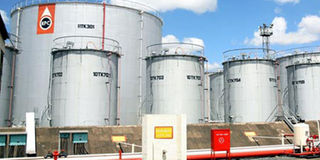Police unearth another fuel racket at Kenya Pipeline

A Kenya Pipeline Company depot in Nairobi. PHOTO | FILE | NATION MEDIA GROUP
What you need to know:
- For the last one year, oil marketers have been complaining about the loss of fuel worth billions of shillings but so far, it had not been established with accuracy how millions of litres of fuel disappeared in an automated system.
The ousted KPC management of Mr Joe Sang used to pass off the loss as due to spillage, theft and evaporation. This was either passed on to consumers or paid by the insurance.
Detectives have unearthed yet another multimillion shilling oil racket at Kenya Pipeline Company. They are currently investigating who compromised the tie-in at Pump Station No 8 in Konza and whether it has been used to siphon fuel.
Early on Tuesday morning, the trio of Director of Criminal Investigations George Kinoti, the Director of Public Prosecution Noordin Haji and Kenya Revenue Authority Director-General James Mburu made an unannounced visit to Pump Station 8 (PS-8) and were shown the tie-in, which was not originally part of the new scandal-ridden Line 5 pipeline — recently built by Zakhem.
CONTROL ROOM
On arrival, they went straight to the control room, according to eyewitnesses, and started gathering evidence.
A tie-in is a term used in the oil sector to describe the connection of a pipeline to a facility. Typically, it has automated valves and metres which allow easier monitoring of the amount of fuel that pass through, and is connected remotely to a control room.
For the last one year, oil marketers have been complaining about the loss of fuel worth billions of shillings but so far, it had not been established with accuracy how millions of litres of fuel disappeared in an automated system.
The ousted KPC management of Mr Joe Sang used to pass off the loss as due to spillage, theft and evaporation. This was either passed on to consumers or paid by the insurance.
Last year, KPC reported that 11.6 million litres of fuel had been lost through leakages and vandalism on the pipeline over a two-year period. The petroleum products lost would translate to Sh1.2 billion at the average cost of Sh100 a litre.
The tie-in pipeline under investigation is connected to a private terminal along Mombasa Road. Mr Kinoti and Mr Mburu confirmed that investigations are in progress.
SUPERVISED
“We are looking at a racket that could run into billions of shillings,” was all Mr Kinoti said when asked about his sojourn at Pump Station 8.
The investigations have come at a time when a special audit on the integrity of the pipeline was demanded by oil marketing companies after KPC reported huge fuel losses in its system.
“The trio were very particular on what they were looking for. They wanted to know how a tie-in, which was not part of the original design, was consummated, and who authorised it,” said a KPC insider privy to the questioning.
It has also emerged that the tie-in construction was supervised by a former KPC technician.
“The automatic valves were isolated electrically by disconnecting the wires, and thus the valves could not be operated remotely,” said an engineer. By doing so, the valves ceased to be computerised and oil movement was measured manually. As a result, there is no data captured on the amount of fuel released to the depot.
“The temperature sensors, which are used to calculate the actual volume, were also isolated as well as the pressure sensor,” said the engineer.
TANK-DIPPING
Detectives found that the “transfer metre” was not working and that workers were using the rudimentary “tank-dipping” method, which is not accurate and can be abused.
Without a proper working valve, insiders say it becomes easier to siphon fuel from the pipeline without leaving an electronic footprint. Whether this happened, and who knew what at KPC is now at the heart of the investigations. More so, by isolating the automated valves, fuel can also be loaded directly into tanks.
The team also visited the metering area and left with some screen shots which indicated that the valves were not being monitored.
“They wanted to know who gave instructions to isolate the valves, who in KPC supervised the works and what the management knew,” said our source.
Another area of interest was at both gates of the oil terminal, which records all the vehicles that leave and enter the facility.
“What is clear is that the custody transfer was compromised at PS8,” said the source.
Custody Transfer in the oil and gas industry refers to the transactions involving transporting physical substance from one operator to another.




